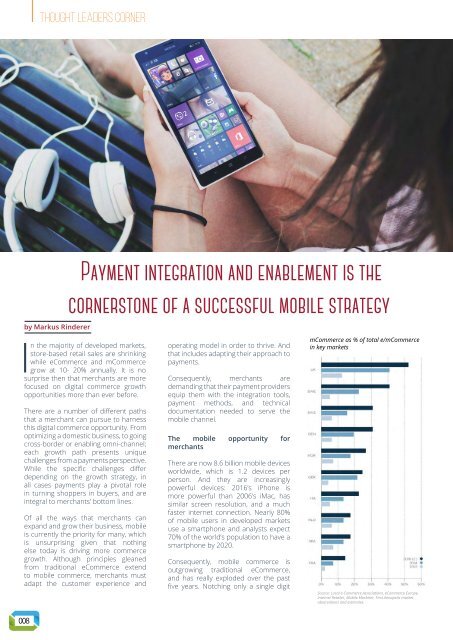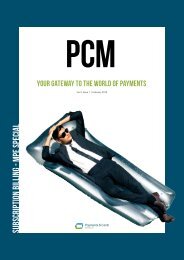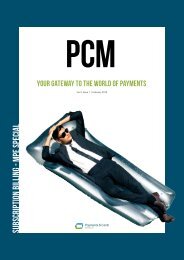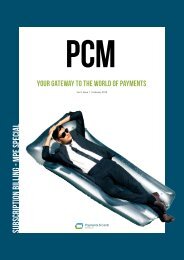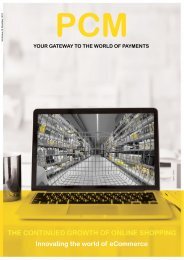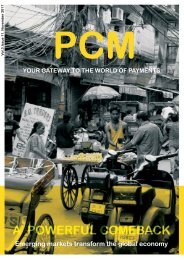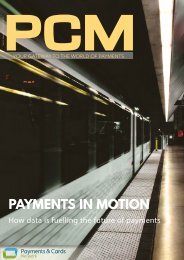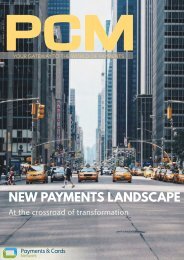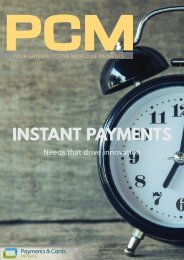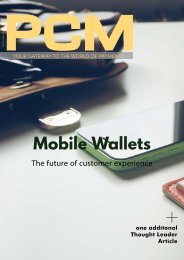PCM Vol. 2 - Issue 11
In a world where goods and services are increasingly purchased online, businesses have to find ways to ensure seamless online shopping experiences. Due to this trend offering Recurring Payments and subscription payment options have become a necessary change. Get more insight inside the eMag!
In a world where goods and services are increasingly purchased online, businesses have to find ways to ensure seamless online shopping experiences. Due to this trend offering Recurring Payments and subscription payment options have become a necessary change. Get more insight inside the eMag!
Create successful ePaper yourself
Turn your PDF publications into a flip-book with our unique Google optimized e-Paper software.
Thought Leaders Corner<br />
by Markus Rinderer<br />
Payment integration and enablement is the<br />
cornerstone of a successful mobile strategy<br />
In the majority of developed markets,<br />
store-based retail sales are shrinking<br />
while eCommerce and mCommerce<br />
grow at 10- 20% annually. It is no<br />
surprise then that merchants are more<br />
focused on digital commerce growth<br />
opportunities more than ever before.<br />
There are a number of different paths<br />
that a merchant can pursue to harness<br />
this digital commerce opportunity. From<br />
optimizing a domestic business, to going<br />
cross-border or enabling omni-channel;<br />
each growth path presents unique<br />
challenges from a payments perspective.<br />
While the specific challenges differ<br />
depending on the growth strategy, in<br />
all cases payments play a pivotal role<br />
in turning shoppers in buyers, and are<br />
integral to merchants’ bottom lines.<br />
Of all the ways that merchants can<br />
expand and grow their business, mobile<br />
is currently the priority for many, which<br />
is unsurprising given that nothing<br />
else today is driving more commerce<br />
growth. Although principles gleaned<br />
from traditional eCommerce extend<br />
to mobile commerce, merchants must<br />
adapt the customer experience and<br />
operating model in order to thrive. And<br />
that includes adapting their approach to<br />
payments.<br />
Consequently, merchants are<br />
demanding that their payment providers<br />
equip them with the integration tools,<br />
payment methods, and technical<br />
documentation needed to serve the<br />
mobile channel.<br />
The mobile opportunity for<br />
merchants<br />
There are now 8.6 billion mobile devices<br />
worldwide, which is 1.2 devices per<br />
person. And they are increasingly<br />
powerful devices: 2016’s iPhone is<br />
more powerful than 2006’s iMac, has<br />
similar screen resolution, and a much<br />
faster internet connection. Nearly 80%<br />
of mobile users in developed markets<br />
use a smartphone and analysts expect<br />
70% of the world’s population to have a<br />
smartphone by 2020.<br />
Consequently, mobile commerce is<br />
outgrowing traditional eCommerce,<br />
and has really exploded over the past<br />
five years. Notching only a single digit<br />
mCommerce as % of total e/mCommerce<br />
in key markets<br />
Source: Local e-Commerce Associations, eCommerce Europe,<br />
Internet Retailer, Mobile Marketer, First Annapolis market<br />
observations and estimates.<br />
008


